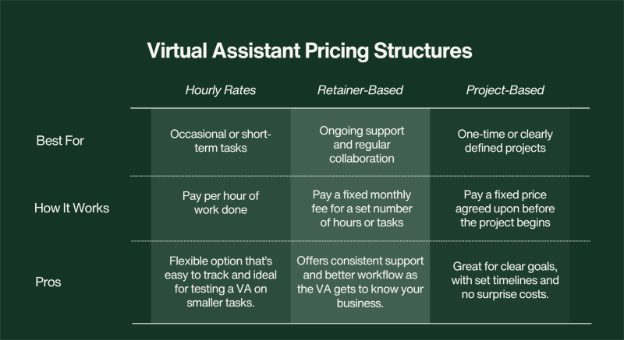What Does a Virtual Assistant Charge? A Simple Guide to VA Rates in 2025
At a glance
The role of virtual assistants has grown far beyond basic admin support. In 2025, many businesses rely on them for everything from project coordination to customer communication.
They’re becoming essential to how modern teams work. That shift raises a practical question: what does a virtual assistant charge in 2025? With more companies hiring remotely, understanding VA rates is now part of smart business planning.
Whether you're hiring one for admin help, calendar management, or more specialised work, understanding how VA rates are structured can help you make a smarter decision for your budget. In this guide, we’ll walk you through what affects VA pricing, the most common payment setups, and what to expect when hiring in today’s digital-first world.
What Is a Virtual Assistant?
A virtual assistant is someone who works remotely to support business owners, professionals, or teams with a wide range of tasks. Instead of being physically present in an office, VAs work online, helping out wherever they're needed.
They can take on tasks such as:
- Administrative work
- Social media management
- Customer support
- Content creation
- Basic graphic design
- Project coordination
Many VAs have specialised skills, making them valuable for businesses that want flexible support without hiring a full-time employee. By handling time-consuming tasks, VAs free up business owners to focus on strategy and growth.
If you're looking for a reliable way to get matched with skilled virtual assistants, platforms like HireHarbour make it easy to find someone who fits your needs. They do the vetting for you, so you get trusted, qualified support without the long search.

What Affects a Virtual Assistant’s Rate?
Virtual assistant rates can vary a lot, and it’s not just about experience. The kind of tasks they handle, where they live, and the tools they need all play a part in how much they charge. Understanding these factors can help you set the right budget and find the best VA for your needs.
Type and Complexity of Tasks
Not all tasks are created equal. A VA who helps with basic admin tasks like checking emails or setting appointments may charge less. But if you're asking them to handle things like social media content, SEO, or graphic design, the rates are usually higher. That’s because these jobs require specific skills, tools, and strategy.
In short, the more complex the work, the more you can expect to pay. It’s a reflection of their expertise and the value they bring to your business.
Where the VA Is Based
A VA’s location can also affect how much they charge. Those living in places with higher living costs, like major cities, tend to have higher rates. On the other hand, VAs from areas with a lower cost of living may offer more affordable pricing.
That’s why many businesses choose to work with remote VAs from different parts of the world. Just keep in mind that working across time zones or cultures might require some adjustments, but it can be worth it for the savings.
Tools and Software
Some tasks need special tools like project management software, design platforms, or marketing tools. If a VA has to use paid tools to get the job done, they may charge more to cover those costs.
These tools also often require training and regular updates, so part of what you’re paying for is their ability to use these tools efficiently. Supporting your VA with the right tools ensures smoother workflows and better results for your business.

What Kind of Work Do Virtual Assistants Do?
Virtual assistants can handle a wide variety of tasks depending on what you or your business need support with. From admin duties to creative or technical projects, their flexibility allows you to delegate work without committing to a full-time hire.
This means you can save time, reduce costs, and focus on priorities, all while ensuring the work still gets done professionally.
- Administrative Tasks
One of the most common reasons people hire VAs is for help with general administrative work. This includes managing email inboxes, setting appointments, updating spreadsheets, organising digital files, and doing basic research. These are time-consuming tasks that can be easily outsourced to free up your day.
- Finance-Related Work
Some VAs specialise in financial support. They can assist with bookkeeping, invoice preparation, expense tracking, and even basic payroll tasks. For small businesses or startups, this type of support is especially useful when a full-time accountant isn’t yet necessary.
- Executive-Level Support
Virtual assistants can also function as remote executive assistants. They help manage calendars, coordinate travel arrangements, handle internal communication, and assist with team projects. This level of support is ideal for entrepreneurs or busy professionals who need someone reliable to help keep operations running smoothly.
- Marketing and Social Media
If your business needs a stronger online presence, VAs with marketing experience can help. They create and schedule social media posts, write newsletters, assist with email marketing campaigns, and even analyse performance metrics. It's a great way to stay visible without adding more to your plate.
- Customer Support
Many VAs are trained in customer service and can assist with answering emails, processing orders, managing inboxes, and handling basic customer enquiries. This helps your business stay responsive and professional, especially if you run an e-commerce site or service-based business.

Virtual Assistant Pricing Structures
Hiring a virtual assistant can be a smart move for busy entrepreneurs, growing businesses, or anyone who needs help managing daily tasks. From handling emails and calendar scheduling to managing social media and doing research,
VAs offer flexible support. But before bringing one on board, it’s important to understand how their pricing works. Knowing the different pricing models can help you choose the right setup based on your needs and budget.
Here are the most common ways virtual assistants charge for their services:
Hourly Rates
Many virtual assistants charge by the hour. This is a simple and flexible option if you’re unsure how many hours of help you’ll need. You only pay for the time they spend on your tasks. It’s a great choice if you just need occasional support or are trying out a virtual assistant for the first time.
Hourly rates can vary based on the type of task, the VA’s skill level, and where they’re located. For instance, someone handling basic admin work may charge less than a VA with experience in social media strategy or graphic design. Tools like time trackers are often used to make sure the hours are logged properly.
Retainer-Based Rates
If you need help regularly, a retainer model might be better. This means you pay a fixed fee each month for a set number of hours or services. It gives you peace of mind knowing your assistant is available when needed, and it’s easier to plan your budget.
This model works well for ongoing tasks like customer service, email management, or content scheduling. Since the assistant works with you consistently, they get to know your workflow better, which can lead to better results over time.
Project-Based Rates
Some virtual assistants offer fixed pricing for one-time projects. This works well if you have a clear goal and deadline, like setting up a newsletter, designing a presentation, or writing blog posts.
With this model, you agree on a total cost upfront. It helps with financial planning since there are no surprise charges. Project-based pricing is great when you don’t need regular help but want quality results for specific tasks. Payment terms are usually set before the work starts, sometimes half upfront and the rest after completion.
The Strategic Value of Virtual Assistants for Businesses
Bringing virtual assistants into your team can help make things run more smoothly and boost productivity. Business owners often count on VAs to handle tasks like social media management, project management, and general admin work. Having a VA can be a smart move, especially if you want to keep things efficient without the extra costs of hiring full-time staff, such as sick pay, holiday pay, or national insurance.
This setup gives business owners more time to focus on growing the business. By looking at what the company needs and matching that with the VA’s skill set, it becomes easier to hand off work and get more done. That’s why virtual assistants are becoming trusted team members for businesses aiming to grow and scale.

Selecting the Right Communication Tools
Effective communication is the backbone of a productive working relationship between business owners and virtual assistants. Selecting the most suitable tools can significantly impact how smoothly tasks are executed, especially when managing time-sensitive responsibilities like social media management, digital marketing initiatives, or customer engagement.
Platforms such as Slack, Microsoft Teams, and Zoom enable real-time communication, promote accountability, and support efficient project coordination. It's important to choose tools that align with your operational framework and your virtual assistant's working style. Additionally, compatibility across time zones and accessibility during agreed-upon working hours are essential to maintaining consistent collaboration.
Establishing Reliable Payment Channels
Clear and timely compensation is essential in fostering a professional and dependable partnership with a virtual assistant. The chosen payment channels should reflect the agreed-upon pricing structure, whether hourly rates, retainer agreements, or project-based arrangements.
Options such as PayPal, Wise (formerly TransferWise), or direct bank transfers offer efficient and traceable payment solutions. Clearly defined payment terms and cycles help prevent misunderstandings and ensure that your virtual assistant is compensated fairly and promptly. This is especially important when VAs have their own operational costs to manage, such as software subscriptions or equipment.
Reliable payment methods not only support financial transparency but also help build trust and long-term collaboration.
Conclusion
Virtual assistants are now a key part of how many businesses run. They help get things done faster, support daily operations, and free up your time so you can focus on bigger priorities. With different pricing options like hourly, monthly retainers, or per project it’s important to choose what works best for your setup.
Good communication and clear payment methods are also important. Using tools that make it easy to talk and share updates helps avoid confusion. And choosing reliable ways to send payments keeps things smooth and professional on both sides.
When these parts are set up well, working with a virtual assistant can be a great long-term solution. It helps your business run more smoothly and grow with less stress.
For quick productivity hacks, the latest trends in virtual executive assistance, and insights to help you get more done, follow HireHarbour on LinkedIn. It’s time to make a difference!
Ready to make every second count?



.svg)

.png)

